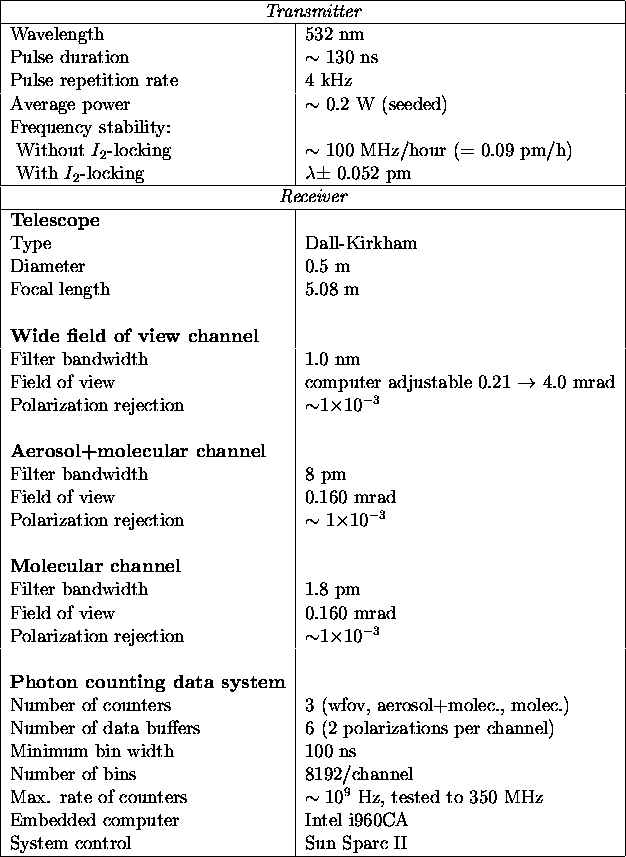



Next: Transmitter
Up: Introduction
Previous: An overview of
Return to the Publications.
Return to the Index.
The instrument has been modified to measure polarization and a separate
channel has been added to measure both polarization and signal amplitude
variations as function of receiver field of view. These modifications
allow discrimination between ice and water clouds and measurements of
multiple scattering. Along with these modifications, the high resolution
etalon, used in the earlier versions of the HSRL, has been replaced
with an iodine absorption filter. Also, the system has been redesigned
for use in a semitrailer.
Other changes include new data
acquisition system, temperature controlled environment
for the receiver optics, and improved optical design.
The system parameters of the HSRL are summarized in Table 1.
The changes to the HSRL have improved the measurement
capabilities of the HSRL. With the new HSRL, the measurements
of the optical parameters of the atmosphere below 35 km can
be made and therefore, the measurements can cover
clouds from water clouds to high altitude cirrus clouds and
also measurements of stratospheric aerosol layers can be performed.
Clouds with optical depths up to  3 can be measured.
This means that
most of the cirrus cloud cases can be fully observed and the
cloud bases of the thick water clouds can be measured up to
300-500 m inside the cloud.
This has been achieved by
using a high pulse repetition rate, small pulse energy per laser
pulse, and very fast photon counting electronics. Furthermore,
the averaging time
required for a good signal to noise ratio has been decreased by improving
the optical transmission of the system. The use of the iodine
filter, the controlling of the
pressure of the etalons and the temperature of the optics, and the
locking of the laser wavelength to an iodine absorption peak
have increased the stability and the reliability of the system.
Therefore, the need for frequent calibrations is eliminated and
a stable operation can be maintained over a long period of time.
The enhanced calibration technique has improved the accuracy of
the HSRL calibrations.
3 can be measured.
This means that
most of the cirrus cloud cases can be fully observed and the
cloud bases of the thick water clouds can be measured up to
300-500 m inside the cloud.
This has been achieved by
using a high pulse repetition rate, small pulse energy per laser
pulse, and very fast photon counting electronics. Furthermore,
the averaging time
required for a good signal to noise ratio has been decreased by improving
the optical transmission of the system. The use of the iodine
filter, the controlling of the
pressure of the etalons and the temperature of the optics, and the
locking of the laser wavelength to an iodine absorption peak
have increased the stability and the reliability of the system.
Therefore, the need for frequent calibrations is eliminated and
a stable operation can be maintained over a long period of time.
The enhanced calibration technique has improved the accuracy of
the HSRL calibrations.

Table 1: HSRL specifications (April 26, 1994)




Next: Transmitter
Up: Introduction
Previous: An overview of
Return to the Publications.
Return to the Index.
Paivi Piironen
Tue Mar 26 20:49:55 CST 1996
 3 can be measured.
This means that
most of the cirrus cloud cases can be fully observed and the
cloud bases of the thick water clouds can be measured up to
300-500 m inside the cloud.
This has been achieved by
using a high pulse repetition rate, small pulse energy per laser
pulse, and very fast photon counting electronics. Furthermore,
the averaging time
required for a good signal to noise ratio has been decreased by improving
the optical transmission of the system. The use of the iodine
filter, the controlling of the
pressure of the etalons and the temperature of the optics, and the
locking of the laser wavelength to an iodine absorption peak
have increased the stability and the reliability of the system.
Therefore, the need for frequent calibrations is eliminated and
a stable operation can be maintained over a long period of time.
The enhanced calibration technique has improved the accuracy of
the HSRL calibrations.
3 can be measured.
This means that
most of the cirrus cloud cases can be fully observed and the
cloud bases of the thick water clouds can be measured up to
300-500 m inside the cloud.
This has been achieved by
using a high pulse repetition rate, small pulse energy per laser
pulse, and very fast photon counting electronics. Furthermore,
the averaging time
required for a good signal to noise ratio has been decreased by improving
the optical transmission of the system. The use of the iodine
filter, the controlling of the
pressure of the etalons and the temperature of the optics, and the
locking of the laser wavelength to an iodine absorption peak
have increased the stability and the reliability of the system.
Therefore, the need for frequent calibrations is eliminated and
a stable operation can be maintained over a long period of time.
The enhanced calibration technique has improved the accuracy of
the HSRL calibrations.




